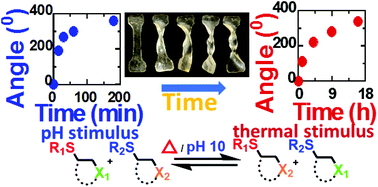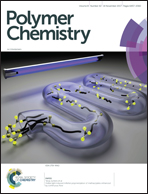Dual stimuli responsive self-healing and malleable materials based on dynamic thiol-Michael chemistry†
Abstract
Thiol-maleimide adducts have been used as dynamic crosslinkers to form soft, elastic, and stimuli responsive polymeric materials. Thiol-Michael adducts can undergo dynamic exchange at elevated temperature or elevated pH values. Due to the dynamic behaviour of thiol-Michael adducts, crosslinked polymeric materials display significant healing after cutting into half, and malleability upon exposure to solutions of elevated pH. These materials are also thermally responsive, showing self-healing properties and malleability at high temperatures (90 °C). The self-healing properties of these polymer materials are significantly higher than materials with non-dynamic crosslinkers. In addition, in mechanical stability experiments, these materials showed creep resistance and complete creep recovery at room temperature and pressure. These results indicate that the thiol-Michael reaction is dynamic and reversible in response to thermal and pH stimuli. These stimuli responsive self-healing, elastic, malleable, and mechanically stable polymeric materials open the door to have potential utilization in different applications such as coatings or elastomers with extended lifetimes.



 Please wait while we load your content...
Please wait while we load your content...